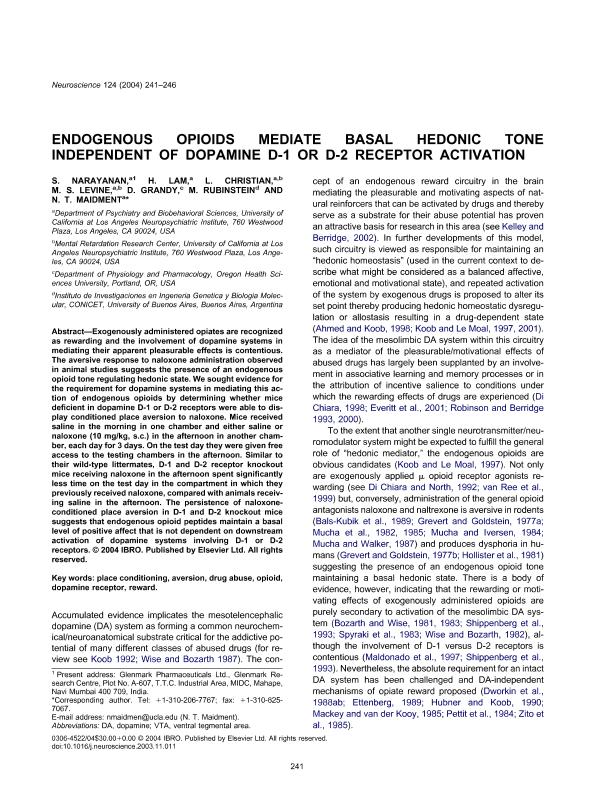Mostrar el registro sencillo del ítem
dc.contributor.author
Narayanan, S.
dc.contributor.author
Lam, H.
dc.contributor.author
Christian, L.
dc.contributor.author
Levine, M. S.
dc.contributor.author
Grandy, D.
dc.contributor.author
Rubinstein, Marcelo

dc.contributor.author
Maidment, N. T.
dc.date.available
2019-07-16T20:47:26Z
dc.date.issued
2004-01
dc.identifier.citation
Narayanan, S.; Lam, H.; Christian, L.; Levine, M. S.; Grandy, D.; et al.; Endogenous opioids mediate basal hedonic tone independent of dopamine d-1 or d-2 receptor activation; Pergamon-Elsevier Science Ltd; Neuroscience; 124; 1; 1-2004; 241-246
dc.identifier.issn
0306-4522
dc.identifier.uri
http://hdl.handle.net/11336/79701
dc.description.abstract
Exogenously administered opiates are recognized as rewarding and the involvement of dopamine systems in mediating their apparent pleasurable effects is contentious. The aversive response to naloxone administration observed in animal studies suggests the presence of an endogenous opioid tone regulating hedonic state. We sought evidence for the requirement for dopamine systems in mediating this action of endogenous opioids by determining whether mice deficient in dopamine D-1 or D-2 receptors were able to display conditioned place aversion to naloxone. Mice received saline in the morning in one chamber and either saline or naloxone (10 mg/kg, s.c.) in the afternoon in another chamber, each day for 3 days. On the test day they were given free access to the testing chambers in the afternoon. Similar to their wild-type littermates, D-1 and D-2 receptor knockout mice receiving naloxone in the afternoon spent significantly less time on the test day in the compartment in which they previously received naloxone, compared with animals receiving saline in the afternoon. The persistence of naloxone-conditioned place aversion in D-1 and D-2 knockout mice suggests that endogenous opioid peptides maintain a basal level of positive affect that is not dependent on downstream activation of dopamine systems involving D-1 or D-2 receptors.
dc.format
application/pdf
dc.language.iso
eng
dc.publisher
Pergamon-Elsevier Science Ltd

dc.rights
info:eu-repo/semantics/openAccess
dc.rights.uri
https://creativecommons.org/licenses/by-nc-sa/2.5/ar/
dc.subject
Aversion
dc.subject
Dopamine Receptor
dc.subject
Drug Abuse
dc.subject
Opioid
dc.subject
Place Conditioning
dc.subject
Reward
dc.subject.classification
Neurociencias

dc.subject.classification
Medicina Básica

dc.subject.classification
CIENCIAS MÉDICAS Y DE LA SALUD

dc.title
Endogenous opioids mediate basal hedonic tone independent of dopamine d-1 or d-2 receptor activation
dc.type
info:eu-repo/semantics/article
dc.type
info:ar-repo/semantics/artículo
dc.type
info:eu-repo/semantics/publishedVersion
dc.date.updated
2019-07-16T14:12:42Z
dc.journal.volume
124
dc.journal.number
1
dc.journal.pagination
241-246
dc.journal.pais
Países Bajos

dc.journal.ciudad
Amsterdam
dc.description.fil
Fil: Narayanan, S.. University of California at Los Angeles; Estados Unidos
dc.description.fil
Fil: Lam, H.. University of California at Los Angeles; Estados Unidos
dc.description.fil
Fil: Christian, L.. University of California at Los Angeles; Estados Unidos
dc.description.fil
Fil: Levine, M. S.. University of California at Los Angeles; Estados Unidos
dc.description.fil
Fil: Grandy, D.. Oregon Health Sciences University; Estados Unidos
dc.description.fil
Fil: Rubinstein, Marcelo. Consejo Nacional de Investigaciones Científicas y Técnicas. Instituto de Investigaciones en Ingeniería Genética y Biología Molecular "Dr. Héctor N. Torres"; Argentina. Universidad de Buenos Aires; Argentina
dc.description.fil
Fil: Maidment, N. T.. University of California at Los Angeles; Estados Unidos
dc.journal.title
Neuroscience

dc.relation.alternativeid
info:eu-repo/semantics/altIdentifier/url/https://www.ncbi.nlm.nih.gov/pubmed/14960355
dc.relation.alternativeid
info:eu-repo/semantics/altIdentifier/doi/http://dx.doi.org/10.1016/j.neuroscience.2003.11.011
dc.relation.alternativeid
info:eu-repo/semantics/altIdentifier/url/https://www.sciencedirect.com/science/article/pii/S0306452203008698
Archivos asociados
